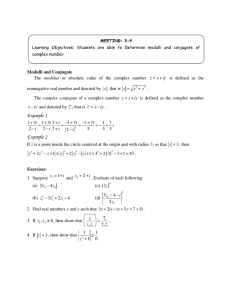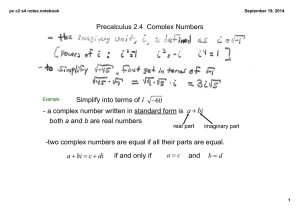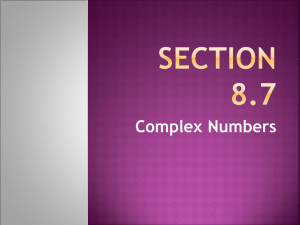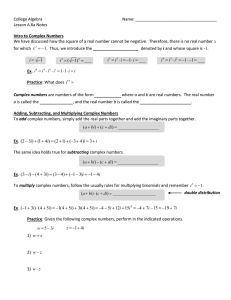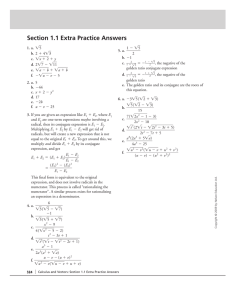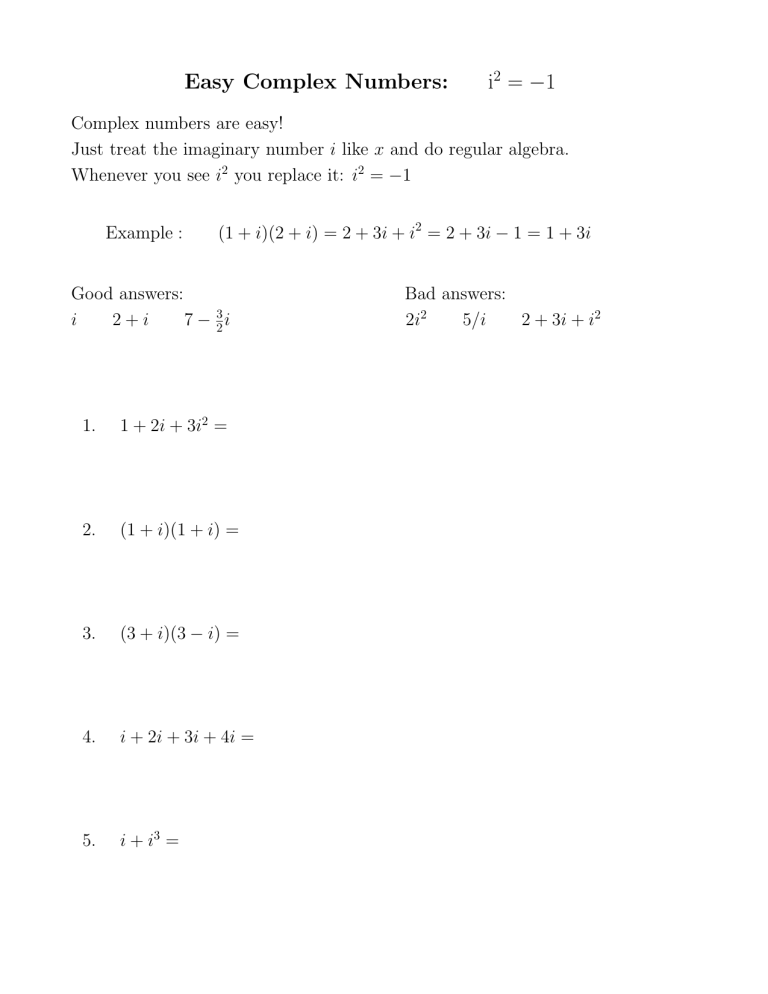
Easy Complex Numbers: i2 = −1 Complex numbers are easy! Just treat the imaginary number i like x and do regular algebra. Whenever you see i2 you replace it: i2 = −1 Example : (1 + i)(2 + i) = 2 + 3i + i2 = 2 + 3i − 1 = 1 + 3i Good answers: i 2+i 7 − 32 i 1. 1 + 2i + 3i2 = 2. (1 + i)(1 + i) = 3. (3 + i)(3 − i) = 4. i + 2i + 3i + 4i = 5. i + i3 = Bad answers: 2i2 5/i 2 + 3i + i2 6. 1 + i + i2 + i3 = 7. (i2 )(i2 ) = 8. i4 = 9. i5 = Since i2 = −1 we have 10. 11. 12. 13. √ √ √ √ −16 = −25 = −π 2 = −π = √ −1 = i, so √ −9 = √ √ −1 9 = 3i The Power of I !!!! (well . . . powers of i) 0. i0 = 1 True for any number: A0 = 1 1. i1 = i True for any number: A1 = A 2. i2 = −1 The definition of the imaginary number i 3. i3 = i2 · i = −i 4. i4 = i2 · i2 = (−1)(−1) = 1 -or- (except A = 0) Follows from i2 = −1 Follows from i2 = −1 i4 = i3 · i = (−i)(i) = −i2 = 1 Follows from i3 = −i In this way one can reduce all the powers of i to 1, i, −1, or − i Try doing this by completing this tableau: i0 = i4 = i8 = i12 = i1 = i5 = i9 = i13 = i2 = i6 = i10 = i14 = i3 = i7 = i11 = i15 = i4 = i8 = i12 = i16 = Do you notice a pattern? How do you calculate i2019? √ Roots of Negative Numbers: 0. 1. 2. 3. 4. 5. 6. 7. 8. √ √ √ √ √ √ √ √ √ −1 = i −4 = −9 = √ √ −1 = i This is the basis for everything. √ √ −1 4 = 2i Factor out −1, then solve. √ −1 9 = Solve this yourself. −16 = −25 = −49 = −100 = −0.01 = −π 2 = π is the ratio of a circle’s circumference to its diameter 9. √ −b2 = b is a positive real number 10. √ −π = Algebra with i: Just replace i2 with −1 0. (1 + i)(2 + i) = 1 + 2i + i2 = 1 + 2i − 1 = 2i i2 → −1 1. 3i(5 + 7i) = 15i + 21i2 = 15i − 21 i2 → −1 Note: this is the same as −21 + 15i 2. (2 + 3i)(5 + 7i) = 3. (2 + 3i)2 = (2 + 3i)(2 + 3i) = 4. (2 + 3i)(2 − 3i) = 5. (1 + i)(1 − i) = 6. (3 + 5i)(3 − 5i) = 7. (a + bi)(a − bi) = a and b are real numbers. a − bi is called the complex conjugate of a + bi The product of a complex number and its conjugate is always real. Complex Numbers: Powers of i: i0 = 1 i1 = i Level 1 i2 = −1 fill in the rest below: i0 = i4 = i8 = i1 = i5 = i9 = i2 = i6 = i10 = i3 = i7 = i11 = Notice the pattern ... it repeats every 4th power. In general, i4n = 1 for any integer n. √ √ −1 = i −9 = 3i Square Roots of Negative Numbers: √ √ √ The trick is −25 = −1 ∗ 25 = i ∗ 5 = 5i 1. 2. 3. 4. 5. 6. √ √ √ √ √ √ −4 = −16 = −36 = −49 = −81 = −144 = Complex Numbers: Algebra of i: Level 2 treat i like a variable x, but always replace Do algebra first, then replace i2 with −1 and then simplify. 1. i(1 + i) = 2. i(1 − i) = 3. (1 + i)(1 + i) = 4. (1 + i)(1 − i) = 5. (2 + 3i)(2 − 3i) = 6. (5 + 7i)(5 − 7i) = 7. (a + bi)(a − bi) = i2 → −1 : Complex Numbers: Powers of i Level 3 we saw they repeat every 4th power: i4n = 1 i4n+1 = i i4n+2 = −1 i4n+3 = −i So any power of i is determined by the remainder after dividing the power by 4: i23 = i4∗5+3 = i4∗5i3 = (i4)5i3 = (1)5i3 = i3 = −i 23 = 4 ∗ 5 + 3 or 23 mod 4 = 3 or 23%4 = 3 The remainder of 23 after dividing the by 4 is 3, so i23 = i3 = −i Find each of the following large powers of i: 1. i17 = 2. i31 = 3. i54 = 4. i68 = 5. i131 = 6. i231 = 7. i931 = Complex Numbers: Level 4 Division and the Complex Conjugate A complex number z = 2 + 3i has conjugate z ∗ = 2 − 3i (just negate the i part). The product zz ∗ is always both real and positive: zz ∗ = (2 + 3i)(2 − 3i) = 4 − 9i2 = 4 + 9 = 13 In general, if z = x + iy, the conjugate is z ∗ = x − iy and zz ∗ = (x + iy)(x − iy) = x2 − i2 y 2 = x2 + y 2 This is useful in division, where we agree with the French and the Japanese that all denominators should be real and positive. So whenever we see a complex denominator we multiply top and bottom by its conjugate: 2 + 3i (2 + 3i) (5 − 7i) FOIL 31 + i 31 1 = = 2 = = + i 2 5 + 7i (5 + 7i) (5 − 7i) 5 +7 74 74 74 Note the deceptively simple case with just i in the denominator: (3 + 4i) (−i) FOIL 4 − 3i 3 + 4i = = = = 4 − 3i 2 i (i) (−i) −i 1 Do division by multiplying top and bottom by the conjugate of the bottom: 1. 1+i = 1−i 2. 2 + 5i = 2 + 3i 3. 2 − 5i = 2 − 3i Complex Numbers: Mixed Problems 1. 1 + i + i2 + i3 + i4 + i5 + i6 + i7 = 2. 1 1 + = 1−i 1+i 3. 1 + i2 + i 4 = i + i3 + i5 4. 5. 6. √ −49 − √ −36 = (1 + i)4 = (1 + i)2 (1 + i)2 = √3 + i 2 2 = Level 5 Complex Numbers: Level 6 Hard Problems √3 + i 3 1. = 2 2. Suppose z = x + iy = √ i Find x and y by noting that z 2 = i

